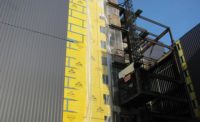College students face many challenges throughout their four, or five, or even eight years of higher education. They develop as adults, as individuals, as a community of students with similar goals during their time in school. Much can be said for the cold formed steel trusses that have become a regular part of new construction projects on Washington University in St. Louis’ Danforth campus in St Louis. The latest project, the Thomas Eliot B Dormitory, sports a complex and intricate roof system consisting of 350 unique cold formed steel truss designs. Ultra-Span fabricator/partner Engineered Steel Products teamed with St. Charles, Mo., based panelizer and framing contractor Gateway Panels to deliver yet another successful cold formed project to the St. Louis region.
Washington University, founded in 1853, maintains an elite reputation as an institution of higher learning in many academic fields, including medicine, engineering, research, and law. As its website states, “To promote learning, the University encourages independence, boldness, and originality of thought.”
The same can be said for the buildings, both old and new, that dot the 169-acre Danforth campus. Several older campus buildings, in fact, have even been listed on the National Register of Historic Places. Suffice it to say, expectations are always high when new structures are added to this historic and regal campus.
PRECENDENT DAY
The Eliot B Dormitory (part of the University’s South 40 Redevelopment Project) is no exception and is a real show-piece in many respects. The “infill” structure is the fourth in a series of new residence halls that comprise the new, European streetscape-styled South 40 residential area. Due to the extremely tight job site, Gateway Panel has had a year-long challenge of staging, delivering, hoisting and installing factory-built wall panels and roof trusses with minimal interruption to everyday campus life taking place literally a few feet away. Gateway attributes much of its success to their steel truss supplier, Engineered Steel Products, based in Wright City, Mo. Engineered Steel was required to sequence delivery of the trusses on a very specific schedule, so that Gateway could pre-assemble sections of the roof at their facility and deliver to the jobsite, ready to lift right into place.
According to Bruce Schierding, estimator and project manager with Gateway Panel, “This has to be a record. I’ve never seen a project go up so fast. We asked ESP to deliver certain roof sections on an extremely rigid schedule, and they came through without a hitch—something previous truss suppliers have been unable to do.”
Without the skill and reliability of Engineered Steel and cold-formed steel trusses there could have been significant challenges and delays. In fact, even with the production schedule squeezed from 16 weeks down to 12 weeks, Engineered Steel met every demand.
| Project notes |
| Project: |
| Thomas Eliot B. Dormitory (South 40 Residential Redevelopment) Washington University, St. Louis http://reslife.wustl.edu/ |
| Ultra-Span Fabricator: |
| Engineered Steel Products Wright City, Mo. |
| General Contractor: |
| Clayco, St. Louis http://claycorp.com/ |
| Architect: |
| Mackey Mitchell Architects, St. Louis http://mackeymitchell.com |
| Engineer: |
| ASDG LLC, Fairview Heights, Ill. http://asdgllc.com |
| Truss Installer: |
| Gateway Panel, St. Charles, Mo. http://www.gatewaypanel.com |
NOT LINCOLN LOGS
Cold-formed steel was the best choice for this structure for many reasons. First, given the life expectancy of this structure, the materials used needed to stand the test of time. Using organic materials such as wood framing would immediately introduce temperance to the structural framing. Cold-formed steel is an inorganic and stable product. It does not twist, warp, split and crack as it ages and transitions through climate cycles. In addition, cold-formed steel is 100 percent non-combustible. The first step in reducing the chance of fire damage in a structure is to remove the fuel (wood) from the structural elements.
Cold-formed steel also contains a high recycled content. According to the Steel Recycling Institute (www.recycle-steel.org), 83.3 percent of new steel used comes from recycled steel. And, by taking full advantage of cold-formed steel and reducing the amount of heavy structural steel, the weight of structures can often be significantly reduced. All of these elements added together can greatly reduce the impact of new construction on our environment. This is reflected in the U.S. Green Building Council’s LEED program. The LEED rating systems offers credits within its Materials and Resources sections, 4.1 and 4.2. Because material credits are awarded based on the percentage of the entire structure, increased use of cold-formed steel, with its high recycled content, will improve the likelihood of a structure qualifying for these points.
Architects Mackey Mitchell considered the positive contributions of cold formed steel trusses and walls when selecting the framing materials. The students living in the newly constructed Eliot B. Dormitories will likely give little thought to the framing materials used to make up their home for the school year. However, Washington University and everyone involved in the construction of these dorms will know that the materials used were chosen with great consideration for sustainability.









Report Abusive Comment